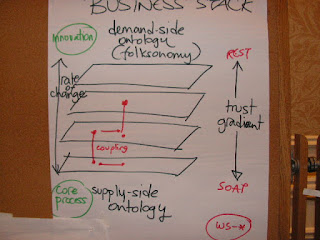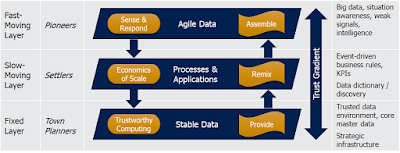The first point to emphasize is that there are many elements to your overall data strategy, and these don't all work at the same tempo. Data-driven design methodologies such as Information Engineering (especially the James Martin version) were based on the premise that the data model was more permanent than the process model, but it turns out that this is only true for certain categories of data.
So one of the critical requirements for your data strategy is to manage both the slow-moving stable elements and the fast-moving agile elements. This calls for a layered approach, where each layer has a different rate of change, known as pace-layering.
The concept of pace-layering was introduced by Stewart Brand. In 1994, he wrote a brilliant and controversial book about architecture, How Buildings Change, which among other things contained a theory about evolutionary change in complex systems based on earlier work by the architect Frank Duffy. Although Brand originally referred to the theory as Shearing Layers, by the time of his 1999 book he had switched to calling it Pace Layering. If there is a difference between the two, Shearing Layers is primarily a descriptive theory about how change happens in complex systems, while Pace Layering is primarily an architectural principle for the design of resilient systems-of-systems.
In 2006, I was working as a software industry analyst, specializing in Service-Oriented Architecture (SOA). Microsoft invited me to Las Vegas to participate in a workshop with other industry analysts, where (among other things) I drew the following layered picture.
 |
| SPARK Workshop Day 2 |
Here's how I now draw the same picture for data strategy. It also includes a rough mapping to the Trimodal approach.
Giles Slinger and Rupert Morrison, Will Organization Design Be Affected By Big Data? (J Org Design Vol 3 No 3, 2014)
Wikipedia: Information Engineering, Shearing Layers
Related Posts: Layering Principles (March 2005), SPARK 2 - Innovation or Trust (March 2006), Enterprise Tempo (October 2010), Beyond Bimodal (May 2016), Data Strategy - Agility (December 2019)

No comments:
Post a Comment